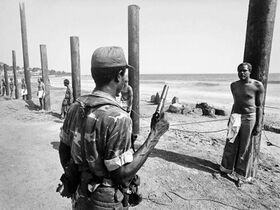1980 Maracan coup d'état attempt
This article is incomplete because it is pending further input from participants, or it is a work-in-progress by one author. Please comment on this article's talk page to share your input, comments and questions. Note: To contribute to this article, you may need to seek help from the author(s) of this page. |
| 1980 Maracan coup d'état attempt | |||||||
|---|---|---|---|---|---|---|---|
 Soldiers of the Revolutionary Army question Movimento Azul members whilst tied to posts, Guajaratuba, 1980 | |||||||
| |||||||
| Belligerents | |||||||
|
|
| ||||||
| Commanders and leaders | |||||||
|
|
| ||||||
| Strength | |||||||
| est. 2,000[a] | 7,000 | ||||||
| Casualties and losses | |||||||
|
129 killed 1,026 POWs | 391 killed or injured | ||||||
The 1980 Maracan coup d'état attempt, referred to in Maracao as the Month of Solidarity (Lusitan: Mês de Solidariedade) or simply O Mês ("The Month") was an attempted coup d'état by the right-wing Movimento Azul, backed principally by Halland and Nuxica, to overthrow Leonardo Alcântara and the Frente Revolucionária de Libertação in an attempt to install a right-wing dictatorship in Maracao aligned against the Association for International Socialism. The coup attempt took place between mid-June and mid-July in 1980, and ended with the capture and execution of its leader, Manuel da Silva, as well mass governmental purges by Alcântara, the imprisonment of most Movimento Azul members and the preservation of Maracao's socialist government.
Background
Since the Liberação in the 1930s led by Renato Guimarães and Josué Couto that freed the island from Mariranan occupation during the Great War, Maracao had been a council communist state aligned with Chistovodia and Swetania, with all three countries espousing relatively similar iterations of socialist ideology. While Maracao was almost directly opposed to much of the Asterias in a geopolitical sense, it remained relatively cooperative on matters of shipping lanes and trade that emerged with Maracao's central location in the Arucian Sea, allowing trade to flow freely and securely through the sea without the threat of interruption. While Maracao was an exemplary democracy and one of the best country's for workers' rights and unionisation, it was still relatively poorly developed by the 1950s, especially compared to its neighbours such as Imagua and the Assimas and Sanslumiere. When Enéas Almeida succeeded to the presidency of Maracao in 1958 upon the death of Matheus Moreno, he devised an ideological plan to distance Maracao from the traditional council communist model employed in much of the socialist world at the time, instead declaring that Maracao was in need of its own, unique version of socialism to ensure maximal development across the country.
Throughout the 1960s, Almeida introduced reforms, policies and delivered speeches that gradually encouraged the promotion of the FRL to the position of a vanguard party in the country, with it quickly becoming the dominant socialist party in Maracan politics. Almeida also attempted to increase Maracan influence abroad, and began utilising Maracao's military dominance among the Arucian states, as well as its relatively high degree of mobility amongst the populace, to begin introducing stricter trade policies and sea enforcement that greatly decreased the security of Arucian trade routes. Whilst Chistovodia was skeptical of the new Maracan government, it continued to send it foreign aid, and along with socialist North Vinalia, provided essential funds that kept the Maracan economy afloat as many Asterian nations embargoed it throughout the mid-1960s, including both Halland and Nuxica. Almeida also pushed to support Chistovodia in its war against Nuxica in the 1970s, and oversaw the training of Chistovodian guerrillas in Maracao. When Almeida left office in favour of his successor Alcântara in 1973, Maracao had vastly increased its development with several new highways, ports and railroads as well as a massive increase in essential infrastructure in much of Maracao's largest cities.
As both Halland and Nuxica had large amounts of shipping passing through the Arucian Sea, it was desirable for both nations to move to secure trade in the region. Halland sent increasing amounts of vessels to Mordred Naval Base in Imagua while Nuxica increased its military funding in the late 1970s back to pre-war levels. Halland began using military vessels to escort essential trade near Maracao, to which Maracao filed a diplomatic complaint with the Community of Nations that was promptly dismissed in March 1978. Maracao began patrolling its own waters more aggressively with its own naval forces and tensions heightened in the straits between the two countries. With the threat of Swetanian involvement looming and public opinion strongly against a second war with Chistovodia, Halland and Nuxica devised Operation Escalona in early 1979, which saw weapons discreetly smuggled into Maracao for the newly-established right-wing Movimento Azul – led by da Silva and strongly supporting alignment with both Halland and Nuxica – through southern port towns that were poorly policed. Da Silva himself was a veteran in the Revolutionary Army and had considerable knowledge of the inner workings of the government as well as influence over other soldiers, which he utilised to recruit for the coup.
Course of the coup
June
July
Aftermath
Legacy
Notes
- ↑ Numbers between 5,000 and 7,000 have been claimed by the Maracan government, although these claims are routinely disputed.